
When it’s time to harvest and butcher our homestead-raised pigs, we want to know how to get the most out of a pig carcass. After all our work raising them, there should be no waste to speak of, right? And pigs are especially versatile meat animals. As the old saying goes, there’s a use for “everything but the squeal.”
But finding how all those parts are most useful on your farm isn’t just a matter of looking up traditional or especially inventive charcuterie recipes.
What if your family just isn’t willing to eat blood pudding? Suppose paté doesn’t appeal to you? Or the thought of a roast boar’s head on the dinner table doesn’t make you want to give up your Christmas turkey?
Not to worry. “There are lots of ways to skin a cat,” as Shawn’s grandfather used to say. And there are many ways to honor and respect a whole pig carcass without making yourself eat grilled kidneys.
Read more: Learn the hows, whys and whens of pastured pigs.
Breaking It Down
Butchering days are always celebratory on our farm. There’s a lot of work involved. The sheer volume can be intimidating. But this day means the freezer and smoke house will once again be packed with the necessary materials for many of our favorite meals:
- pork roasts to grace our sauerkraut
- thick, juicy chops to grill over a wood fire
- spicy herbed sausage or savory bacon to go with our morning eggs and potatoes
Yes, we love to see the fruits of our healthy farm ecosystem harvested and stored for feeding our family.
Most of the carcass break-down is routine—hams and shoulders, bellies and chops, hocks and all the various roasts. Some organ meats may pose a challenge, though.
And what about all those bones and the really bony parts, like the head? This is where we have to start making decisions.
Your first step should probably be research. There are some excellent guides out there for making responsible and delicious use of every last scrap of whatever you butcher. Our personal favorites are:
- Brandon Sheard’s Farmstead Meatsmith videos on Youtube
- Doug and Andy’s videos and workshops from Hand Hewn Farm in Fresno, Ohio
- Vermont chef Cole Ward’s Gourmet Butcher video series
When we have a question about any of our own practices, these are the sources we use. But there is a lot of meat curing information available out there these days. We encourage you to look around.
Read more: You can harvest pigs at any age and stage for maximum herd efficiency.
Keeping It on the Farm
In the actual world of our farms and homesteads, real appetites, food preferences and chores need to balance with honor for the pig carcass we harvest and butcher. When it’s time to move on to the next homestead job, here are some good fallbacks for completing a respectful harvest, knowing you have used every last scrap of your pig:
- All those esoteric organs—pancreas, spleen, lungs and so on–can be ground and added to your poultry ration. A fist-sized lump of miscellaneous ground meat per five birds will give a good boost of protein in their diet. And this translates into more eggs.
- Bones stripped of accessible meat (trim meat goes for sausage) are the basis for excellent broth. Roast the bones, simmer and can up the results. Don’t forget the heads and feet. Your cooking reaches new heights with plenty of good broth to work with. Burying the cooked bones in the compost pile returns phosphorus to the soil.
- Learn to clean intestines for sausage casings. It’s not difficult or dangerous, and you’ve never had a really top-notch sausage until you’ve had it in a natural casing.
- There is no such thing as too much lard, so don’t waste a single scrap of that good pig fat. Running it through the grinder before rendering means less cracklings, but more lard. So suit yourself.
Harvesting your own pigs at home is one more way to keep resources on the farm. The price of the butcher, meat itself and all the other bits and scraps (which would be lost to us if we sent our pig to the abbatoir) can all stay at home and bless the family, the plants and animals, and the soil.
So sharpen up your best knives and get ready to butcher your pig meat. You will find that you do, indeed, use “everything but the squeal.”




